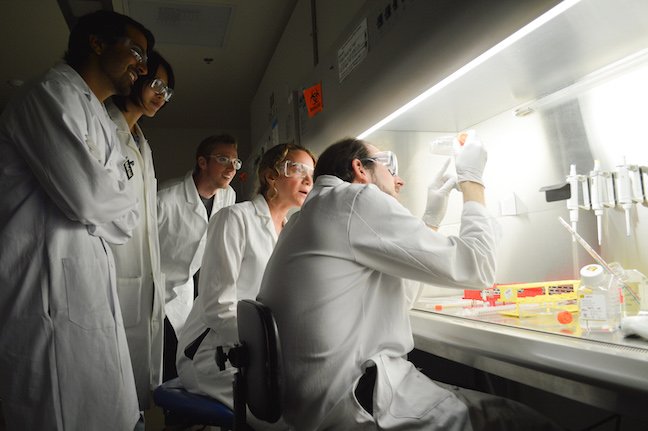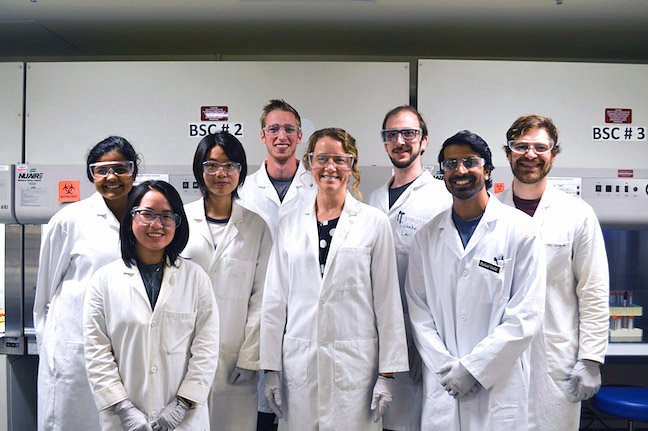Building blocks to success

Above: Students gather in Reineke's cell culture lab.
Credit: Olivia Hultgren
Professor uses polymers in gene therapy research—and gives students industry experience
July 29, 2019
For Theresa Reineke, making polymers is like building with Legos.
“Designing these systems on the molecular level, it’s almost like taking Legos and assembling them into a chain,” she said. “Each Lego might be a little different, and what role that building block plays is something we have to understand.”
The College of Science and Engineering professor specializes in polymer chemistry, and her lab is currently engineering polymers as a means to deliver more affordable gene therapy to patients with various illnesses.
Gene therapy involves altering the genes inside the body’s cells to treat or stop diseases. It also requires a carrier—often a modified virus—to deliver the transformed DNA directly into the body.
However, Reineke said this process costs researchers a lot of money and time—upwards of $500,000 per dose. By contrast, polymers are inexpensive and can be produced at a much faster pace, making them a more efficient option for packaging, or carrying, the DNA.
“A longstanding effort of my group has been to package therapeutic genetic payloads like DNA and RNA,” Reineke said. “There are literally tens of thousands of diseases that don’t have cures that this type of therapy could help.”
Innovation on the industry level
Now, Reineke and the students in her lab are working with Limelight Bio, a Philadelphia-based biotech startup that develops DNA drugs to treat hereditary diseases.
“Our work is more translational in that things we discover in our lab are of interest to industry,” Reineke explained. “That’s something I really like, because students actually see the potential clinical outcome for the things they’re doing.”
While Limelight Bio produces the therapeutic DNA, Reineke and her students design polymers tailored to different tissue types so that the DNA can be delivered seamlessly into different areas of body. The project is currently in the pre-clinical animal testing phase, but with enough progress, human clinical trials could be on the horizon.
And, Reineke’s students have been just as involved in this collaboration as she has, doing everything from sending polymers to helping with animal testing in Philadelphia.
“Innovation in industry is happening more at the startup level now,” she said. “It’s potential future employers for some of these grad students.
“If they get a Ph.D. in the area this company is working in,” she explained, “it could be a way for them to get hired and see this technology through an FDA approval pipeline.”
Reineke said her biggest enjoyment will always be working with her students, watching them learn and in turn, learning from them.
“They’re the ones who are really doing the projects,” she said. “They’re the ones taking the Legos and putting them together and seeing if they work.”

Student-centric
On top of experiencing industry work on a startup level, Reineke’s students are thriving in the lab’s collaborative, multidisciplinary environment.
“We’re the College of Science and Engineering, so there’s a big chemistry, material sciences and chemical engineering aspect to this project,” Reineke said. “Having students from all of those backgrounds really helps give a unique perspective to building, characterizing, and going back to optimize the engineering of these molecules.”
Ramya Kumar, a postdoctoral associate in the Reineke group, works on the data science end of things, using computers to predict the structures of polymers before making them. While she comes from a chemical engineering background, Kumar said it’s interesting to see how chemists think about engineering systems.
“I learn a lot from all of my lab mates because all of them bring in such unique experiences and skills,” she said.
“Even people who are working in other areas like sustainable polymers or drug delivery tend to ask really probing questions and help us think about things differently,” Kumar said.
“Theresa is the perfect mix of chemistry and biology,” said chemistry graduate student Zhe Tang. “She uses polymer chemistry and polymer physics to solve biological problems. We’re still doing research, but maybe eventually we can treat diseases for actual people.”
Intellect aside, the students agree that the best part of their research is its timely, real-world impact.
“It’s cool, we’re working on stuff that may actually be put into patients one day,” said Craig Van Bruggen, also a chemistry grad student. “We’re working on stuff that could potentially be used in a clinic months from now.”
Many of Reineke’s graduate students and postdoc researchers are supported by funds from Limelight Bio as well as a grant from the Defense Advanced Research Projects Agency.
“The best part about working in chemistry and engineering compared to a lot of other graduate programs is that you don’t have to go into mass debt in order to get a Ph.D.,” Van Bruggen said.
“You’re supported financially throughout your Ph.D., which is crucial,” he added.
Reineke also received a $100,000 Distinguished McKnight Professorship from the University of Minnesota, which goes directly into funding the students’ and their research, in addition to supplies and equipment for the lab.
“Donors provide these funds that can go directly into paying students to work on something that is extremely innovative and has an impact on human health,” she said. “And with that money I can fund new efforts, like this gene therapy project, that might spark the interest of a company and be translated into a medicine faster.”
Story by Olivia Hultgren
With excerpts from Legacy magazine, University of Minnesota Foundation
If you’d like to support research at the University of Minnesota College of Science and Engineering, visit our CSE giving page.
